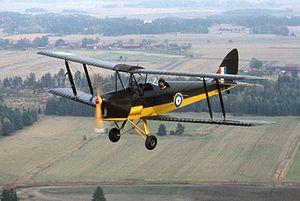De Havilland Tiger Moth
| DH.82 Tiger Moth | |
|---|---|
 |
|
| A Tiger Moth in 1989 | |
| Role | Trainer |
| Manufacturer |
de Havilland Aircraft Company de Havilland Canada |
| Designer | Geoffrey de Havilland |
| First flight | 26 October 1931 |
| Introduction | February 1932 |
| Retired | 1959 |
| Status | Retired from military service, still in civil use |
| Primary users |
Royal Air Force Royal Canadian Air Force Royal Australian Air Force Royal New Zealand Air Force |
| Produced | 1931–1944 |
| Number built | 8,868 |
| Developed from | de Havilland DH.60 Moth |
| Variants | Thruxton Jackaroo |
The de Havilland DH.82 Tiger Moth is a 1930s biplane designed by Geoffrey de Havilland and built by the de Havilland Aircraft Company. It was operated by the Royal Air Force (RAF) and many other operators as a primary trainer aircraft. In addition to the type's principal use for ab-initio training, the Second World War saw RAF Tiger Moth operating in other capacities, including maritime surveillance, defensive anti-invasion preparations, and even some aircraft that had been outfitted to function as armed light bombers.
The Tiger Moth remained in service with the RAF until it was succeeded and replaced by the de Havilland Chipmunk during the early 1950s. Many of the military surplus aircraft subsequently entered into civil operation. Many nations have used the Tiger Moth in both military and civil applications, and it remains in widespread use as a recreational aircraft in several different countries. It is still occasionally used as a primary training aircraft, particularly for those pilots wanting to gain experience before moving on to other tailwheel aircraft. Many Tiger Moths are now employed by various companies offering trial lesson experiences. The de Havilland Moth club, founded 1975, is now an owners' association offering a mutual club and technical support.
Among the reasons for which de Havilland came to peruse development of the Tiger Moth was the personal dissatisfaction of Geoffrey de Havilland, the company's owner and founder, who sought to produce a light aircraft superior to two of his previous designs, the de Havilland Humming Bird and de Havilland DH.51. From earlier experience, de Havilland knew the difficulty and importance of correctly sizing such an aircraft to appeal to various sectors of the civil market, such as touring, trainer, flying club and private aviation customers; the firm had previously attained a measure of popularity with a scaled down version of the DH.51, designated as the DH 60 de Havilland Gipsy Moth.
...
Wikipedia
